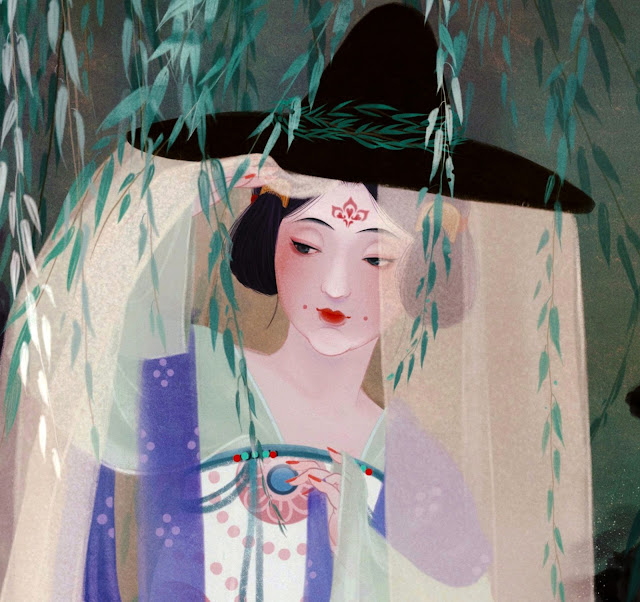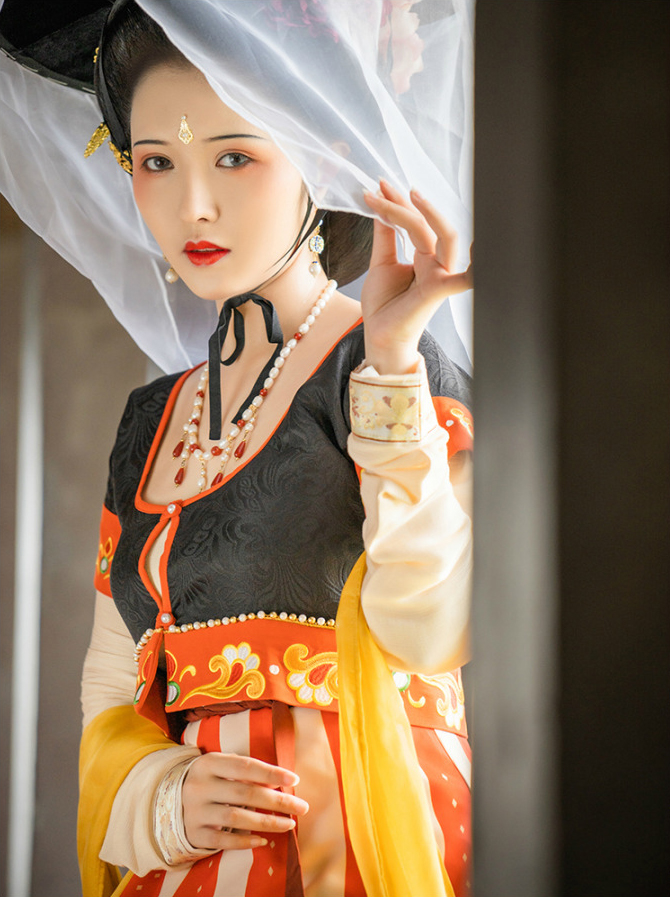Tang Dynasty Veiled Hat: 幂蓠/ 帷帽
Art by 陸曼陀 Danling★Lu
Music: 芒种 "Grain in Ear"
Early Tang dynasty lady in a veiled hat of translucent gauze. Veiled hats are generally referred to as weimao 帷帽in Chinese (lit. "Veiled Hats,") although more precisely, the long, hip or knee- lengthened veiled hats worn in Sui and early Tang dynasty were called mili: 幂蓠.
The long mili likely had Central Asian origins and was usually worn by aristocratic women during their travels so as to obscure their features to passerby's gazes. Though the hat had its origins in modesty, by the Tang dynasty, the mili was greatly shortened, and the far more portable shoulder- lengthened weimao were worn by women of many social classes in the early Tang and Empress Wu's Zhou dynasty.
The tradition of veiled hats was introduced to the Central Plains during the Southern and Northern Dynasties. However the first of these hats were not called weimao: at least no at first. The first type to be worn were called the Mili~ with the translated meaning akin to a "fence."
Central Asian gift-bearer wearing a wide brimmed hat. Veiled hats were used by nomadic people living in northwestern parts of China as a protection against the wind and sand blasts. After the custom came to the Central Plains, it was regarded as fashionable clothing for noble women when playing sports outside.
Mili were quite long and featured prominent veils that extended all the way to the wearer's hips or knees. The mili became popular during the Sui dynasty (581-618,) especially among ladies of the imperial and ducal houses who rode horses on public roads. They were viewed as a conservative statement of nobility and modesty. The fancier veils were adorned with jade and kingfisher feathers. Eventually, the mili’s long veil was shortened toward the end of the Sui, and by the Tang the new wide-brimmed hat with shoulder-lengthed veil became known as the weimao.
WEIMAO: TRANSFORMATION, WIDE ADOPTION
During the Tang dynasty (618-907), the less conservative weimao became so popular that edicts (one in 650 and another in 671) to wear the more modest mili were completely ignored. Women wore them during long travels or while engaging in sports. Not only does the veiled hat protect them against the wind and sands but it also protected the often elaborate make-up worn by such women. By the middle of the 600s it was popular not just among palace women, but also among commoners who followed their lead. This period was contemporaneous with the reign of Wu Zetian, China's only empress.
In general, women enjoyed greater freedom during the liberal Tang dynasty, prior to the Tang, figurines of women riding horses were virtually unseen in China. However during the Tang, there were many figurines and murals depicting women seated on saddles and riding at full gallop. The popular sport of polo was enjoyed not only by princess and generals but also by princesses and noblewomen.
Towards the latter days of the Tang dynasty, eventually the habit of wearing weimao slowly faded within the empire. Gradually- especially in the last days of the Tang empire women's fashions became more ostentatious and featured greater amount of hair accessories. However this would not be the end of such tradition in East Asia. For during the extensive cultural exchange between Tang China and Japan, the Japanese would also adopt this hat as their own.
The Japanese called such hats uchikatsugi, in reference to noble lady's hats, or more generally as the ichimegasa 市女笠: high born lady's straw hat. They were commonly wore by the noble ladies of the Heian period and were in essence very similar to the mili when it was first came to prominence in Sui China.
Unlike the shoulder length-ed weimao, these veil hats functionally were more similar to the mili in that the veils are quite long and were lengthened to the hips and knees. Like the mili they were also designed for the purposes of marking the rider as a member of the aristocratic class and also prevent passer-bys from seeing the features of the noble lady. Unlike the Tang veil hats- which were usually made with a variety of materials ranging from rattan wicker to silk and wire frames, most of the ichimegasa were made of straw matte weaves and has a noticeable protrusion. One can seem them prominently displayed in Japan's annual Jidai Matsuri festival in Kyoto where the fashions of ancient Japan comes to live in an ostentatious parade.
Thank you to my Patrons who has contributed $10 and above: You made this happen!
➢ ☯ Muramasa
➢ ☯ MK Celahir
➢ ☯ Kevin
➢ ☯ Vincent Ho (FerrumFlos1st)
➢ ☯ BurenErdene Altankhuyag
➢ ☯ Stephen D Rynerson
➢ ☯ Michael Lam
➢ ☯ Peter Hellman
➢ ☯ SunB


























Comments
However the images- the illustrations are different.
So yeah deja Vu pal
this one here
https://dragonsarmory.blogspot.com/2019/04/weimao-chinese-veil-hat.html